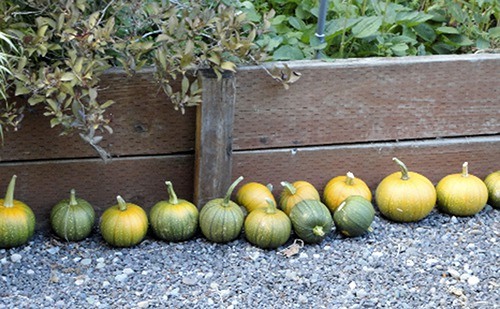Can I eat the fruit on a squash plant that came up voluntarily in my compost pile? It looks different from any squash that I have grown in my garden.
It might surprise you to find out the answer is “no.” Read on for the reason why.
Cucurbitacins are toxins naturally found in plants belonging to the Cucurbit family, the plant family that includes squash, pumpkins, zucchini, cucumbers, melons and gourds. It is thought that these toxins serve as a natural defense mechanism for the plant against insects and herbivores.
When eaten in small amounts, cucurbitacins impart a slightly bitter taste and are not harmful. In larger amounts, however, the toxin may produce a strongly bitter taste and cause stomach cramps, vomiting and diarrhea.
Although cucurbitacins are present in high concentrations in wild cucurbits such as buffalo gourd, domesticated varieties have been bred so that concentrations of the toxin (and the resulting bitterness) are low. Environmental stress (such as high temperatures, inadequate water, low soil fertility and low soil pH) can trigger higher levels of cucurbitacin than usual, but these levels typically are sufficiently low so that the fruits are palatable and do not cause health effects.
Cross-pollination of cultivated plants by wild cucurbits (in the form of weeds growing nearby) can cause problems. Fruits from the parent (the cultivated plant) are not affected and do not exhibit bitterness. Plants grown from seeds from those fruits, however, may produce high levels of cucurbitacin.
Cucurbitacin poisoning is rare. But it does occur. In 2004, the Washington State Department of Health received reports of four people (two from Jefferson County) who became ill from cucurbitacin after eating a squash resembling a small green-and-white striped pumpkin. The squash was purchased locally. Those affected reported that the squash tasted bitter. They each developed stomach cramps and diarrhea; all fully recovered from their illness in less than two days.
The level of the toxin cannot be determined by the appearance of a squash plant or the fruit. To prevent cucurbitacin poisoning, keep the following in mind:
Do not eat wild cucurbits. They are poisonous!
If you eat a cultivated cucurbit with an unusually strong, bitter taste, spit it out. Swallowing even a small amount of a cucurbit with abnormally high cucurbitacin levels has been reported to cause illness. Discard any remaining fruit to avoid illness.
Do not save seed from plants that produced extremely bitter fruits.
If you like to save your own seed, be sure to save fruit only from cucurbit flowers that have been isolated to ensure that pollen came only from another cultivated, non-bitter cucurbit and not from gourds or wild cucurbits. (See sidebar.)
If you do eat a cucurbit that is extremely bitter and experience a gastrointestinal illness suggestive of cucurbit poisoning, call the local poison control center. They can instruct you regarding appropriate medical care.
Only skilled seed savers should try to save seed from cross-pollinated seed crops such as squash, cucumber, melon and pumpkin. If not done properly, the plants grown from the seed (and the fruits on those plants) might not resemble the intended crop and could even be dangerous if consumed. Commercial squash seeds remain viable for several years.
Saving squash seed
To prevent pollination by undesirable cucurbits, follow these steps to save squash and other cultivated cucurbit seeds:
1. Distinguish between male and female flowers. Male flowers are on a longer stalk and do not have a miniature fruit at the base as female blossoms do.
2. With careful observation, note the male and female blossoms that will be opening the next day. Soon-to-open flowers have a light yellow color and a distinct pointed tip.
3. That evening, place a paperclip or small rubber band around both male and female flowers to prevent them from opening.
4. In the morning, pluck the male blossom and touch the cluster of pollen from it to the center of the female flower.
5. Close the female flower again so bees can’t get in.
6. Tag the blossom.
7. Grow the fruit to full maturity for the desired seed. The fruit must be very ripe for the resulting seeds to germinate correctly.
8. Separate the seeds from the fruit flesh and dry them at room temperature.
Source: Sustainable Gardening, The Oregon-Washington Master Gardener Handbook.
Jeanette Stehr-Green is a Washington State University-certified Clallam County Master Gardener.



